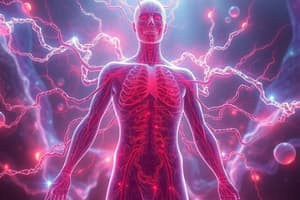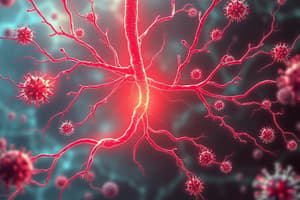Podcast
Questions and Answers
Which lymphoid organ is responsible for the maturation of T cells?
Which lymphoid organ is responsible for the maturation of T cells?
- Lymph nodes
- Spleen
- Thymus (correct)
- Peyer's patches
What organ functions as a blood reservoir and stores platelets?
What organ functions as a blood reservoir and stores platelets?
- Spleen (correct)
- Appendix
- Thymus
- Tonsils
Where are the tonsils primarily located in the body?
Where are the tonsils primarily located in the body?
- Kidneys
- Throat (pharynx) (correct)
- Lungs
- Stomach
What component of the first line of defense offers protection against harmful bacteria present in raw chicken meat?
What component of the first line of defense offers protection against harmful bacteria present in raw chicken meat?
How do natural killer (NK) cells primarily protect the body?
How do natural killer (NK) cells primarily protect the body?
Which statement best defines the body's first line of defense against pathogens?
Which statement best defines the body's first line of defense against pathogens?
What effect does an antihistamine have on the inflammatory response?
What effect does an antihistamine have on the inflammatory response?
Which of the following is NOT considered a nonspecific body defense?
Which of the following is NOT considered a nonspecific body defense?
Which antibody is mainly found in secretions like tears and saliva?
Which antibody is mainly found in secretions like tears and saliva?
What is the primary role of IgE in the immune response?
What is the primary role of IgE in the immune response?
Which option describes how the body primarily addresses cellular antigens?
Which option describes how the body primarily addresses cellular antigens?
What occurs when a foreign blood type is transfused and causes clumping?
What occurs when a foreign blood type is transfused and causes clumping?
What term is used for the blockage of bacterial exotoxins by antibodies?
What term is used for the blockage of bacterial exotoxins by antibodies?
Which immune cells are activated through antigen presentation?
Which immune cells are activated through antigen presentation?
What type of T cell is primarily responsible for releasing cytokines to help fight antigens?
What type of T cell is primarily responsible for releasing cytokines to help fight antigens?
Which type of graft is least likely to succeed in a kidney transplant?
Which type of graft is least likely to succeed in a kidney transplant?
What provides immunity against disease through the injection of serum containing antibodies?
What provides immunity against disease through the injection of serum containing antibodies?
Which type of cells are responsible for developing immunocompetence before responding to specific antigens?
Which type of cells are responsible for developing immunocompetence before responding to specific antigens?
Humoral immunity is primarily provided by which component in the body?
Humoral immunity is primarily provided by which component in the body?
Which statement accurately describes the role of T lymphocytes (T cells)?
Which statement accurately describes the role of T lymphocytes (T cells)?
What determines the specific foreign substances that an immune system can recognize and resist?
What determines the specific foreign substances that an immune system can recognize and resist?
The development of self-tolerance is critical for the functioning of which type of cells?
The development of self-tolerance is critical for the functioning of which type of cells?
Where does the development of B cells' immunocompetence primarily take place?
Where does the development of B cells' immunocompetence primarily take place?
Which cells primarily mediate the adaptive immune response?
Which cells primarily mediate the adaptive immune response?
Which of the following statements is false regarding the immune system?
Which of the following statements is false regarding the immune system?
Which component is NOT one of the main structures of the lymphatic system?
Which component is NOT one of the main structures of the lymphatic system?
Which statement about lymph nodes is correct?
Which statement about lymph nodes is correct?
What is the primary role of the spleen in the lymphatic system?
What is the primary role of the spleen in the lymphatic system?
What is the primary function of the thymus gland?
What is the primary function of the thymus gland?
Which of the following statements regarding lymphocytes is true?
Which of the following statements regarding lymphocytes is true?
Which cell type enables a quick immune response upon subsequent exposure to the same antigen?
Which cell type enables a quick immune response upon subsequent exposure to the same antigen?
Which of the following best describes mechanical barriers in the immune system?
Which of the following best describes mechanical barriers in the immune system?
What is the function of the regulatory T cell in the immune response?
What is the function of the regulatory T cell in the immune response?
What term describes the process by which complement proteins attach to foreign cell surfaces?
What term describes the process by which complement proteins attach to foreign cell surfaces?
Which cell type is responsible for producing large quantities of antibodies?
Which cell type is responsible for producing large quantities of antibodies?
What role does the cytotoxic T cell play in the immune system?
What role does the cytotoxic T cell play in the immune system?
Which of the following is a characteristic function of antigen-presenting cells?
Which of the following is a characteristic function of antigen-presenting cells?
Which cell type undergoes development of immunocompetence in the bone marrow?
Which cell type undergoes development of immunocompetence in the bone marrow?
What is the primary function of helper T cells in the immune response?
What is the primary function of helper T cells in the immune response?
After an infection, which cell type aids in terminating the immune response?
After an infection, which cell type aids in terminating the immune response?
What occurs when soluble antigenic molecules become insoluble and settle out of solution?
What occurs when soluble antigenic molecules become insoluble and settle out of solution?
During the primary humoral response, what happens to B cells that do not become plasma cells?
During the primary humoral response, what happens to B cells that do not become plasma cells?
What is a major function of antigen-presenting cells (APCs) in the immune response?
What is a major function of antigen-presenting cells (APCs) in the immune response?
How does the secondary humoral response differ from the primary humoral response?
How does the secondary humoral response differ from the primary humoral response?
What does the destruction of cilia in the lungs primarily increase the risk of?
What does the destruction of cilia in the lungs primarily increase the risk of?
What type of immunity is primarily facilitated by T cell clones?
What type of immunity is primarily facilitated by T cell clones?
What structural damage do cilia protect against?
What structural damage do cilia protect against?
What happens to the immune response without activated antigen-presenting cells?
What happens to the immune response without activated antigen-presenting cells?
Flashcards
What lymphoid organ stores platelets and acts as a blood reservoir?
What lymphoid organ stores platelets and acts as a blood reservoir?
The spleen is responsible for storing platelets and serving as a blood reservoir, filtering blood, and removing old or damaged red blood cells.
Where are the tonsils located?
Where are the tonsils located?
The tonsils are located in the throat (pharynx), specifically at the entrance of the respiratory and digestive tracts.
Acid mantle
Acid mantle
The acid mantle is a protective layer of slightly acidic sebum and sweat on the skin's surface that helps inhibit bacterial growth.
How do natural killer (NK) cells protect the body?
How do natural killer (NK) cells protect the body?
Signup and view all the flashcards
What is the body's first line of defense against the invasion of disease-causing microorganisms?
What is the body's first line of defense against the invasion of disease-causing microorganisms?
Signup and view all the flashcards
What does an antihistamine prevent?
What does an antihistamine prevent?
Signup and view all the flashcards
What is the inflammatory response?
What is the inflammatory response?
Signup and view all the flashcards
Nonspecific body defenses
Nonspecific body defenses
Signup and view all the flashcards
Adaptive Immunity
Adaptive Immunity
Signup and view all the flashcards
Humoral Immunity
Humoral Immunity
Signup and view all the flashcards
Cell-Mediated Immunity
Cell-Mediated Immunity
Signup and view all the flashcards
Lymphocytes
Lymphocytes
Signup and view all the flashcards
Antigens
Antigens
Signup and view all the flashcards
Self-Tolerance
Self-Tolerance
Signup and view all the flashcards
Immunocompetence
Immunocompetence
Signup and view all the flashcards
B Cell Development
B Cell Development
Signup and view all the flashcards
Lymphatic System Structures
Lymphatic System Structures
Signup and view all the flashcards
Lymph Circulation
Lymph Circulation
Signup and view all the flashcards
Lymph Node Function
Lymph Node Function
Signup and view all the flashcards
Spleen Function
Spleen Function
Signup and view all the flashcards
Thymus Function
Thymus Function
Signup and view all the flashcards
Adaptive Immune System
Adaptive Immune System
Signup and view all the flashcards
Innate Immune System
Innate Immune System
Signup and view all the flashcards
Antibody Production
Antibody Production
Signup and view all the flashcards
Precipitation in Immunity
Precipitation in Immunity
Signup and view all the flashcards
Primary Humoral Response
Primary Humoral Response
Signup and view all the flashcards
Secondary Humoral Response
Secondary Humoral Response
Signup and view all the flashcards
Antigen-Presenting Cells (APCs)
Antigen-Presenting Cells (APCs)
Signup and view all the flashcards
Immune System's First Line of Defense
Immune System's First Line of Defense
Signup and view all the flashcards
Cilia in Respiratory System
Cilia in Respiratory System
Signup and view all the flashcards
Mucus in Respiratory System
Mucus in Respiratory System
Signup and view all the flashcards
Impact of Damaged Cilia
Impact of Damaged Cilia
Signup and view all the flashcards
What is the role of regulatory T cells?
What is the role of regulatory T cells?
Signup and view all the flashcards
What is a plasma cell?
What is a plasma cell?
Signup and view all the flashcards
What is a cytotoxic T cell?
What is a cytotoxic T cell?
Signup and view all the flashcards
What does an antigen-presenting cell (APC) do?
What does an antigen-presenting cell (APC) do?
Signup and view all the flashcards
What is the role of a memory cell?
What is the role of a memory cell?
Signup and view all the flashcards
What is the function of a helper T cell?
What is the function of a helper T cell?
Signup and view all the flashcards
How is lymph formed?
How is lymph formed?
Signup and view all the flashcards
What is the consequence of lymph node removal?
What is the consequence of lymph node removal?
Signup and view all the flashcards
IgE Antibody
IgE Antibody
Signup and view all the flashcards
IgG Antibody
IgG Antibody
Signup and view all the flashcards
IgM Antibody
IgM Antibody
Signup and view all the flashcards
Complement Fixation
Complement Fixation
Signup and view all the flashcards
Agglutination
Agglutination
Signup and view all the flashcards
Neutralization
Neutralization
Signup and view all the flashcards
Helper T Cells
Helper T Cells
Signup and view all the flashcards
Xenograft
Xenograft
Signup and view all the flashcards
Study Notes
Lymphatic System and Body Defenses
- The lymphatic system is crucial for fluid balance and immunity
- Lymph capillaries absorb interstitial fluid and return it to the blood
- Lymph nodes filter lymph, trapping pathogens and immune cells
- The spleen filters blood, removing old red blood cells and pathogens
- The thymus is vital for T cell maturation, crucial for an adaptive immune response
- Peyer's patches are located in the small intestine and help filter pathogens
- Tonsils filter pathogens entering the throat
- Lymphatic collecting vessels, small vessels that transport lymph, return lymph to the blood.
- Lymph capillaries have flap-like mini valves to prevent backflow, are characterized by the presence of flap-like mini valves, and consistently operate under high pressure.
- Lymph nodes are located along lymphatic vessels and filter lymph
Studying That Suits You
Use AI to generate personalized quizzes and flashcards to suit your learning preferences.





